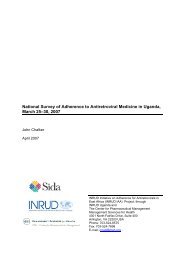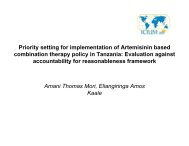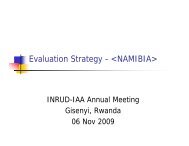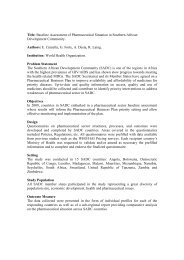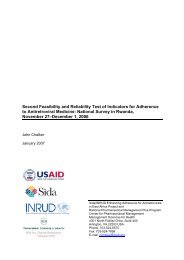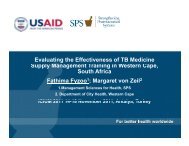How to investigate levels of Adherence to antiretroviral ... - INRUD
How to investigate levels of Adherence to antiretroviral ... - INRUD
How to investigate levels of Adherence to antiretroviral ... - INRUD
Create successful ePaper yourself
Turn your PDF publications into a flip-book with our unique Google optimized e-Paper software.
<strong>How</strong> <strong>to</strong> Investigate <strong>Adherence</strong> <strong>to</strong> Antiretroviral Treatment:<br />
An Indica<strong>to</strong>r-Based Approach<br />
Situation 2.<br />
There is an attendance register, but it does not distinguish between those on<br />
ART and those not on ART; however, there is an ART initiation register<br />
In this situation, another method has <strong>to</strong> be found. As a last resort, this may include sampling<br />
many more than 120 from the attendance register <strong>to</strong> end up with 100 patients on ART. In<br />
many facilities, most patients are seen every month. If this is the case, then one can use the<br />
register <strong>of</strong> ART initiation. Count all the patients who have initiated ART from when the<br />
clinic started <strong>to</strong> up <strong>to</strong> the end <strong>of</strong> the month you are sampling. The sample <strong>of</strong> patients should<br />
be spread evenly across the time <strong>of</strong> initiation.<br />
Situation 3.<br />
There is no attendance register and no ART initiation register, but patient<br />
identifier number is in order <strong>of</strong> initiation<br />
You need <strong>to</strong> check how the pharmacy and clinical notes are s<strong>to</strong>red. It may be that they are<br />
s<strong>to</strong>red by patient identifier numbers and that the numbers correspond <strong>to</strong> the order <strong>of</strong> ART<br />
initiation (the first patient <strong>to</strong> receive ART is number one, the second number two, etc.). If<br />
this is the case, then you need <strong>to</strong> determine the identification number given <strong>to</strong> the last<br />
patient starting ART at the end <strong>of</strong> the month for which you are interested, and sample all<br />
patients who had started before then.<br />
Situation 4.<br />
There is no attendance register, and no ART initiation register. The patient<br />
identification numbers are not allocated in order <strong>of</strong> ART initiation<br />
You need <strong>to</strong> check the <strong>to</strong>tal number <strong>of</strong> patients on ART now and the <strong>to</strong>tal number that were<br />
on ART seven months before and then sample from all patients. The number sampled<br />
should correspond <strong>to</strong> the proportion that had started before the end <strong>of</strong> the month you are<br />
interested in. For example: if now there are 750 patients on ART and seven months ago there<br />
were 500. To find a hundred patients who had initiated before seven months ago, you will<br />
need <strong>to</strong> sample at least [(750/500) * 100] patients which is 150. It would be safer <strong>to</strong> sample<br />
200.<br />
Conclusion<br />
Any set <strong>of</strong> circumstances may be met in practice. Based on experience <strong>to</strong> date (after<br />
80 facilities in 4 countries), it has been possible <strong>to</strong> devise a sensible system for sampling<br />
records. You may need <strong>to</strong> be creative. The key is <strong>to</strong> understand the recording and s<strong>to</strong>rage<br />
systems for both the pharmacy records as well as the attendance register information.<br />
28



